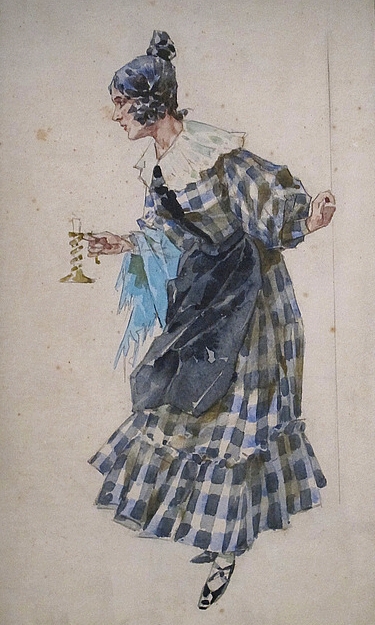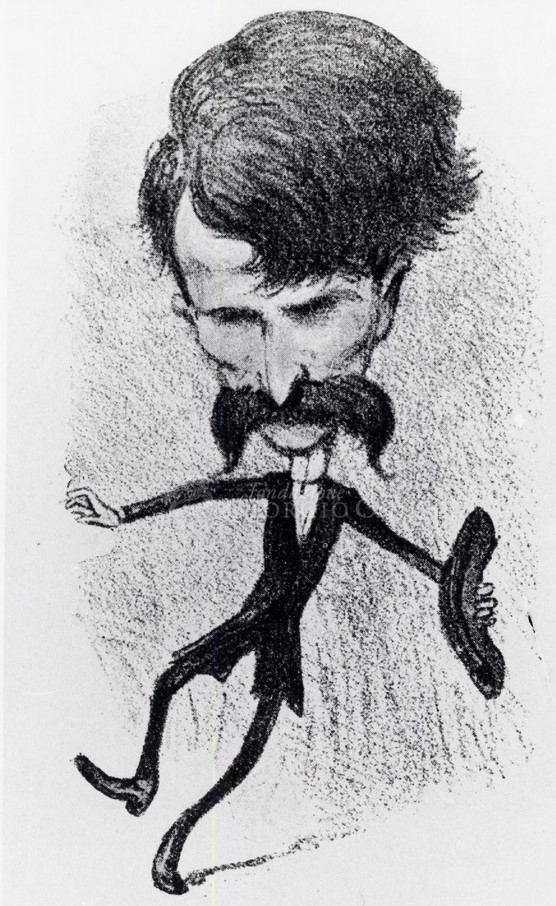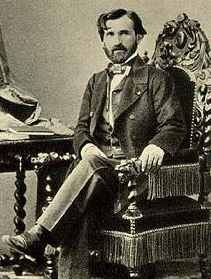|
Cesira Ferrani
Cesira Ferrani (May 8, 1863 in Turin – May 4, 1943 in Pollone) was an Italian people, Italian operatic soprano who is best known for debuting two of the most iconic roles in opera history, Mimì in the original 1896 production of Giacomo Puccini's ''La bohème'' and the title role in Puccini's ''Manon Lescaut (Puccini), Manon Lescaut'' in its 1893 world premiere. Ferrani sang a wide repertoire that encompassed not only verismo opera but the works of composers like Verdi, Gounod, Wagner, and Debussy. Career Born Cesira Zanazzio, Ferrani studied with Antonietta Fricci in Turin before making her professional opera début in 1887 as Micaëla in Bizet's ''Carmen'' at the Teatro Regio di Torino. That same year she sang Gilda from Verdi's ''Rigoletto'' and Marguerite in Gounod's ''Faust (opera), Faust'' at the same theater. Over the next four years she appeared in numerous productions in Catania, Genoa, and Venice. She also sang in several productions in France. In 1892 she appeared a ... [...More Info...] [...Related Items...] OR: [Wikipedia] [Google] [Baidu] |
Teatro Regio Di Torino
The Teatro Regio (Royal Theatre) is a prominent opera house and opera company in Turin, Piedmont, Italy. Its season runs from October to June with the presentation of eight or nine operas given from five to twelve performances of each. Several buildings provided venues for operatic productions in Turin from the mid-16th century, but it was not until 1713 that a proper opera house was considered, and under the architect Filippo Juvarra planning began. However, the cornerstone was not laid until the reign of Charles Emmanuel III in 1738 after Juvarra's death. The work was supervised by Benedetto Alfieri until the theatre was completed and decorated by Bernardino Galliari. Teatro Regio, 1740 to 1936 The Teatro Regio (Royal Theatre) was inaugurated on 26 December 1740 with Francesco Feo's ''Arsace''. It was a sumptuously built facility, seating 1,500 and with 139 boxes located on five tiers plus a gallery. However, the theatre was closed on royal order in 1792 and it became a wareho ... [...More Info...] [...Related Items...] OR: [Wikipedia] [Google] [Baidu] |
Giuseppe Cremonini
Giuseppe Cremonini (25 November 1866 – 9 May 1903) was an Italian operatic tenor who had a prominent opera career in Europe and the United States during the last decade of the nineteenth century. Cremonini was born and died in Cremona, Italy. Admired for his full lyric voice, he sang a wide repertoire that encompassed the bel canto works of Donizetti and Rossini, the Italian grand opera of Verdi, the verisimo operas of Mascagni, the French operas of Gounod and Massenet, and the German operas of Richard Wagner. He sang in several world premieres during his career, including creating the role of Chevalier des Grieux in the original 1893 production of Puccini's ''Manon Lescaut''. An immensely popular singer, Cremonini's career abruptly ended upon his sudden death in 1903 at the age of 36.Riemens, ''A concise biographical dictionary of singers'' Biography Cremonini was born into an impoverished family with the name Giuseppe Bianchi. He studied under a teacher with the su ... [...More Info...] [...Related Items...] OR: [Wikipedia] [Google] [Baidu] |
Puccini
Giacomo Puccini (Lucca, 22 December 1858Bruxelles, 29 November 1924) was an Italian composer known primarily for his operas. Regarded as the greatest and most successful proponent of Italian opera after Verdi, he was descended from a long line of composers, stemming from the late-Baroque era. Though his early work was firmly rooted in traditional late-19th-century Romantic Italian opera, he later developed his work in the realistic ''verismo'' style, of which he became one of the leading exponents. His most renowned works are ''La bohème'' (1896), ''Tosca'' (1900), ''Madama Butterfly'' (1904), and ''Turandot'' (1924), all of which are among the most frequently performed and recorded of all operas. Family and education Puccini was born Giacomo Antonio Domenico Michele Secondo Maria Puccini in Lucca, Italy, in 1858. He was the sixth of nine children of Michele Puccini (1813–1864) and Albina Magi (1830–1884). The Puccini family was established in Lucca as a local musica ... [...More Info...] [...Related Items...] OR: [Wikipedia] [Google] [Baidu] |
La Boheme Costume Mimi
LA most frequently refers to Los Angeles, the second largest city in the United States. La, LA, or L.A. may also refer to: Arts and entertainment Music * La (musical note), or A, the sixth note * "L.A.", a song by Elliott Smith on ''Figure 8'' (album) * ''L.A.'' (EP), by Teddy Thompson * ''L.A. (Light Album)'', a Beach Boys album * "L.A." (Neil Young song), 1973 * The La's, an English rock band * L.A. Reid, a prominent music producer * Yung L.A., a rapper * Lady A, an American country music trio * "L.A." (Amy Macdonald song), 2007 * "La", a song by Australian-Israeli singer-songwriter Old Man River Other media * l(a, a poem by E. E. Cummings * La (Tarzan), fictional queen of the lost city of Opar (Tarzan) * ''Lá'', later known as Lá Nua, an Irish language newspaper * La7, an Italian television channel * LucasArts, an American video game developer and publisher * Liber Annuus, academic journal Business, organizations, and government agencies * L.A. Screenings, a tel ... [...More Info...] [...Related Items...] OR: [Wikipedia] [Google] [Baidu] |
Arturo Toscanini
Arturo Toscanini (; ; March 25, 1867January 16, 1957) was an Italian conductor. He was one of the most acclaimed and influential musicians of the late 19th and early 20th century, renowned for his intensity, his perfectionism, his ear for orchestral detail and sonority, and his eidetic memory. He was at various times the music director of La Scala in Milan and the New York Philharmonic. Later in his career he was appointed the first music director of the NBC Symphony Orchestra (1937–54), and this led to his becoming a household name (especially in the United States) through his radio and television broadcasts and many recordings of the operatic and symphonic repertoire. Biography Early years Toscanini was born in Parma, Emilia-Romagna, and won a scholarship to the local music conservatory, where he studied the cello. Living conditions at the conservatory were harsh and strict. For example, the menu at the conservatory consisted almost entirely of fish; in his later years, ... [...More Info...] [...Related Items...] OR: [Wikipedia] [Google] [Baidu] |
Loreley (opera)
''Loreley'' is an opera (''azione romantica'') in three acts composed by Alfredo Catalani to a libretto by , and others. It premiered on 16 February 1890 at the Teatro Regio in Turin. Based on the German legend of the Lorelei, the opera is an extensive reworking of Catalani's four-act opera ''Elda'' which had premiered in Turin ten years earlier. Background and performance history The praise received by Catalani's ''La falce'', a one-act opera written while he was a student at the Milan Conservatory, led to Giovannina Lucca offering him a contract for more operas. Lucca ran the music publishing house Casa Musicale Lucca that had acquired the rights to publish Wagner's works in Italy. ''Elda'', his first opera for Lucca premiered to critical success in 1880, followed by ''Dejanice'' in 1883 and ''Edmea'' in 1886. Neither of them had the critical success of ''Elda'', but ''Edmea'' went on to be performed both in Italy and internationally. This prompted Lucca to commission a fourt ... [...More Info...] [...Related Items...] OR: [Wikipedia] [Google] [Baidu] |
Alfredo Catalani
Alfredo Catalani (19 June 1854 – 7 August 1893) was an Italian operatic composer. He is best remembered for his operas ''Loreley'' (1890) and ''La Wally'' (1892). ''La Wally'' was composed to a libretto by Luigi Illica, and features Catalani's most famous aria "Ebben? Ne andrò lontana." This aria, sung by American soprano Wilhelmenia Fernandez, was at the heart of Jean-Jacques Beineix's 1981 film ''Diva''. Catalani's other operas were much less successful. Life and career Born in Lucca, Catalani came from a musical family. He was trained at the Milan Conservatory, where his teachers included Antonio Bazzini. Despite the growing influence of the ''verismo'' style of opera during the 1880s and early 1890s, Catalani chose to compose in a more traditional manner, which had traces of Wagner in it. As a result, his operas (''La Wally'' excepted) have largely lost their place in the modern repertoire, even compared to those of Massenet and Puccini, whose style his own periodically re ... [...More Info...] [...Related Items...] OR: [Wikipedia] [Google] [Baidu] |
Simon Boccanegra
''Simon Boccanegra'' () is an opera with a prologue and three acts by Giuseppe Verdi to an Italian libretto by Francesco Maria Piave, based on the play ''Simón Bocanegra'' (1843) by Antonio García Gutiérrez, whose play ''El trovador'' had been the basis for Verdi's 1853 opera, ''Il trovatore''. ''Simon Boccanegra'' was first performed at Teatro La Fenice in Venice on 12 March 1857. Given the complications of the original plot and the generally poor popular response – although the critical one was more encouraging – the opera dropped out of favour after 1866. Finally, 23 years later, Verdi's publisher persuaded the composer to revise the opera, with text changes to be prepared by Arrigo Boito, the librettist who aspired to work with the aging composer on a project which eventually became a new opera, ''Otello'', but to which Verdi had not totally committed at that time. The revised version of ''Simon Boccanegra'', with the now-famous Council Chamber scene, was first perfor ... [...More Info...] [...Related Items...] OR: [Wikipedia] [Google] [Baidu] |
Teatro Carlo Felice
The Teatro Carlo Felice is the principal opera house of Genoa, Italy, used for performances of opera, ballet, orchestral music, and recitals. It is located on the side of Piazza De Ferrari. The hall is named for King Carlo Felice, and dates from 24 December 1824, when the Most Excellent Department of Theatres was established. On 31 January 1825, local architect Carlo Barabino submitted his design for the opera house which was to be built on the site of the church of San Domenico. The Dominican friars were moved elsewhere without delay or ceremony, and the first stone of the new building was laid on 19 March 1826. The inaugural performance of Bellini's ''Bianca e Fernando'' took place on 7 April 1828, even though the structure and decoration were not quite finished. The auditorium accommodated an audience of about 2,500 in five tiers (each with 33 boxes), a gallery above, and standing room in the orchestra pit. The acoustics were considered among the best of the time. For ne ... [...More Info...] [...Related Items...] OR: [Wikipedia] [Google] [Baidu] |
Venice
Venice ( ; it, Venezia ; vec, Venesia or ) is a city in northeastern Italy and the capital of the Veneto Regions of Italy, region. It is built on a group of 118 small islands that are separated by canals and linked by over 400 bridges. The islands are in the shallow Venetian Lagoon, an enclosed bay lying between the mouths of the Po River, Po and the Piave River, Piave rivers (more exactly between the Brenta (river), Brenta and the Sile (river), Sile). In 2020, around 258,685 people resided in greater Venice or the ''Comune di Venezia'', of whom around 55,000 live in the historical island city of Venice (''centro storico'') and the rest on the mainland (''terraferma''). Together with the cities of Padua, Italy, Padua and Treviso, Italy, Treviso, Venice is included in the Padua-Treviso-Venice Metropolitan Area (PATREVE), which is considered a statistical metropolitan area, with a total population of 2.6 million. The name is derived from the ancient Adri ... [...More Info...] [...Related Items...] OR: [Wikipedia] [Google] [Baidu] |
Genoa
Genoa ( ; it, Genova ; lij, Zêna ). is the capital of the Italian region of Liguria and the List of cities in Italy, sixth-largest city in Italy. In 2015, 594,733 people lived within the city's administrative limits. As of the 2011 Italian census, the Province of Genoa, which in 2015 became the Metropolitan City of Genoa, had 855,834 resident persons. Over 1.5 million people live in the wider metropolitan area stretching along the Italian Riviera. On the Gulf of Genoa in the Ligurian Sea, Genoa has historically been one of the most important ports on the Mediterranean Sea, Mediterranean: it is currently the busiest in Italy and in the Mediterranean Sea and twelfth-busiest in the European Union. Genoa was the capital of Republic of Genoa, one of the most powerful maritime republics for over seven centuries, from the 11th century to 1797. Particularly from the 12th century to the 15th century, the city played a leading role in the commercial trade in Europe, becoming one o ... [...More Info...] [...Related Items...] OR: [Wikipedia] [Google] [Baidu] |







.jpg)
.jpg)
